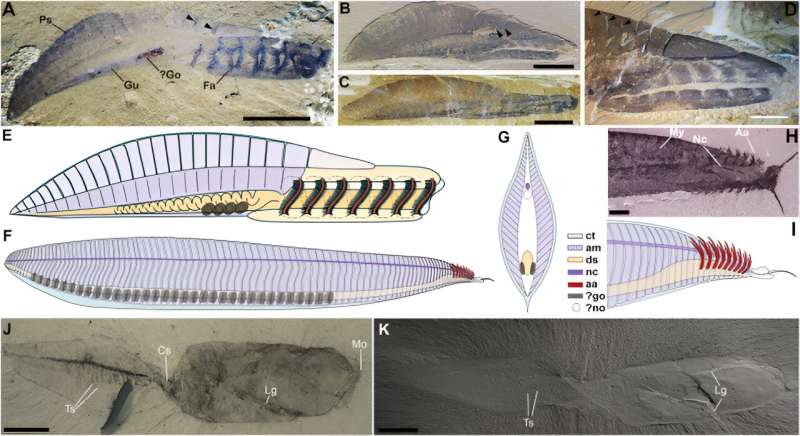June 12, 2024 report
This article has been reviewed according to Science X's editorial process and policies. Editors have highlighted the following attributes while ensuring the content's credibility:
fact-checked
peer-reviewed publication
trusted source
proofread
New research suggests prior studies of ancient sea creature Pikaia had it upside down

A team of marine biologists, Earth scientists and evolutionary specialists affiliated with several institutions in the U.K., has found that prior researchers studying a fossil of an ancient sea creature called Pikaia were looking at it upside down. In their study, published in the journal Current Biology, the group found that a blood vessel running along what was reported to be its belly was actually a dorsal nerve cord.
Prior research has shown that all vertebrates have not only a backbone, but a brain protected by a skull. The reason all vertebrates have these characteristics is that they all evolved from the same creature, a fish that once lived in the Cambrian Sea.
But how that fish developed a backbone and brain is still not known. Evidence of precursors is scarce. Fossils of a variety of creatures have been found, but they are so dissimilar that it has been impossible to build a family tree.
For many years, scientists in the field have pointed to the fossilized remains of Pikaia as a possible precursor. Its fossilized remains were found back in 1910. It is believed to have lived approximately 508 million years ago. It was shaped somewhat like a modern eel and was just 16 centimeters long.
At the time of its discovery, the fossil was believed to be an ancient type of worm, and that belief held up until the team on this new effort took a closer look at it.
In their analysis, the research team found that a long tube, reported as a blood vessel running along the bottom of the creature, was more likely a nerve cord, which would have been on the top of the creature, not the bottom. That meant that all prior studies of the fossil had it upside down. It also more strongly suggested the creature was a precursor to vertebrates. A closer look showed the nerve cord progressing all the way into the head, into what might have been its brain.
The team also found that what had been previously described as a dorsal organ made more sense when it was situated on the creature's belly. The research team also suggests that appendages that were once thought to hang below the creature as it swam were more likely a type of gill outgrowth, extending upward.
More information: A new interpretation of Pikaia reveals the origins of the chordate bodyplan, Current Biology (2024). DOI: 10.1016/j.cub.2024.05.026. www.cell.com/current-biology/f … 0960-9822(24)00669-9
Journal information: Current Biology
© 2024 Science X Network




















